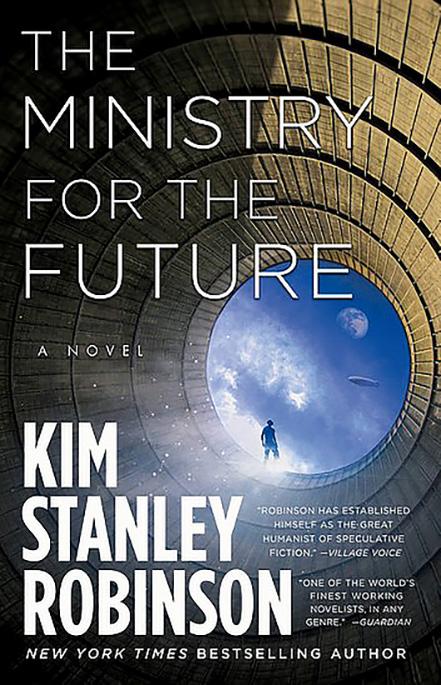
4 minute read
FOR TRANSFORMATION
A FUTURE MINISTRY’S ADVENTURES AND OPTIMISTIC PERSPECTIVES FOR TRANSFORMATION
Book Review by
Edgar Göll
A Review of Kim Stanley Robinson‘s book The Ministry for the Future, London: Orbit 2020
“IT was getting hotter” is the first sentence in Robinsons new book. And this is the basis for the whole story painting for us the not-too-distant future on planet Earth. It dares to think the unthinkable, inconvenient truths about the disastrous effects of our Western dominated capitalist industrial systems, our consumption patterns, and our life styles. Some of the possible and likely responses as described in this book are also inconvenient, even disturbing, including terrorist attacks against destroyers of our life-supporting systems, a.k.a. nature.
There are several major storylines, starting with a massive and deadly heatwave in Uttar Pradesh in India. This provokes the national government to conduct geoengineering that violates the internationally binding Paris Agreement. Hundreds of planes spray sulfur dioxide into the atmosphere in order to temporarily lower the temperature by reducing solar radiation.
The protagonist is Mary Murphy, “Minister for the Future.” That political part of the story starts in 2025 in Bogota, Colombia, at the 29th Conference of the Parties to the United Nations Framework Convention on Climate Change. Frustrated by their failure to meet the goals of the Paris Agreement, representatives of the 189 ratifying countries form a new agency “to advocate for the world’s future generations of citizens” and “to defend all living creatures present and future who cannot speak for themselves.” Its official name is “Subsidiary Body for Implementation of the Agreement” (p. 15), but soon it gets labelled “The Ministry for the Future.” Although it is given a relatively large budget for an UN agency, it doesn’t have much power at the start. But it proves able to achieve its objectives slowly by leveraging its influence and taking strong steps over the years. The Ministry learns from its failures to understand ever better what signals, what communication, what pressure the national governments and administrations need in order to act and deliver. She tries to push the Ministry to wield more influence, devise new instruments and effective tactics, and have more impact for a global sustainable transformation.
With this fictional panorama Robinson describes at least these two principal coping styles vis-á-vis the existential crisis of our civilization: radicalism and terrorism on the one side, and reformism and political incrementalism on the other. These two basic forms are opposing poles of a broad spectrum of reactions to a coming climate catastrophe. In several chapters of the book, he shows many more patterns that support a change for the rescue of the planet.
The major player in this future panorama is the Future Ministry, which tries to coordinate and push activities


and policies for a grand transformation in order to rescue the whole civilization and future generations from ecocide. We get pieces of internal discussions and memos of meetings, showing the complexity and narrow interests of national government’s diplomats, and the inertia and phlegm of that old system. After several efforts the ministry builds a coalition of influential central banks to advance a scheme of global cryptocurrency money-creation via blockchain tied to carbon drawdown, which those technocrats are willing to support. They do not foresee the long-term consequences of this economic mechanism: the end of capitalism as we know it.
At the same time, we learn that many progressive, ecological activities and projects are under way. Things like alternative ways of producing energy, reducing the ecological footprint, and starting a global project called “Half Earth” that consists of building huge corridors of biospheres for wildlife.
But a real transformation seems to need more. To establish the political will for developing more radical programs and accelerating mitigation measures, a key insight is essential. It is about looking back at the 2020s:
And yet still they burned carbon. They drove cars, ate meat, flew in jets, did all the things that had caused the heat wave and would cause the next one. Profits still were added up in a way that led to shareholder dividends. And so on. Everyone alive knew that not enough was being done, and everyone kept doing too little. (p. 228)
The insufficiency of most governmental, business, and individual activities is the ultimate driving force for radicalization and stronger, cascading measures. The most effective seems to be radical direct action, with severe terrorist attacks looming if direct action fails to induce change. In Robinson’s transformation panorama, real affectedness and embarrassment seems to move people – including decision-makers. Those motivations stem from escalating acts of resistance against the destructive megamachine of profit-seeking industrialism. Acts of sabotage and terrorism start proliferating: the World Economic Forum in Davos gets under pressure, fleets of oil tankers are destroyed, drones attack whole fleets of airliners. One particular drone attack against a mine exploiting the earth and the human workforce in Africa is reported, leading to the call of “Africa for Africans.” The essence of all those attacks and executions is labelled “attacks on carbon burners.” The people behind those terrorist attacks are not made visible: they act like a shadow.
The storyline, of course, is much richer and more complex. But it is so important because it will make many readers think more deeply and radically than before. It forces us to think about the need for a systemic transformation, and the adequate use of carrots and sticks to achieve it. All this is definitely not convenient in the novel, and it will not be so in reality. Robinson’s contribution is a great, disturbing, and inspiring book.
Notes:
https://en.wikipedia.org UN Geneva Human Rights and Alliance of Civilizations Room.
Photographer: Ludovic Courtès (Creative Commons CC BY-SA 3.0 DE)










